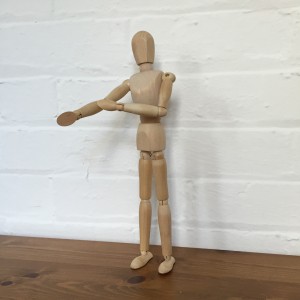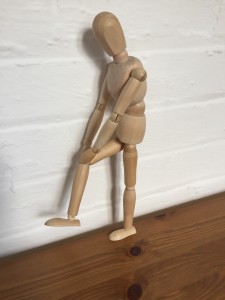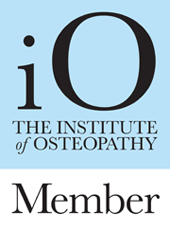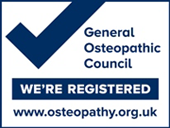Osteopathy, bursitis and tendonitis
 Definitions
Definitions
Bursitis and tendonitis are common conditions causing swelling around the bones and muscles.
A bursa is a small, fluid-filled sac acting as a cushion between two surfaces that rub against each other (e.g. bones, muscles, tendons and skin). Bursae are found throughout the body (approximately 160 of them) and each one is lined with special cells (synovial cells) producing a lubricating liquid that helps to reduce friction between moving body parts. Bursitis is the term given to describe an inflamed bursa.
A tendon is a flexible band of tissue connecting muscles to bones. They can be small (e.g. those found in the hand and foot) or large (e.g. Achilles tendon on the heel). Tendons facilitate bone movement by making the muscles push and/or pull. Tendonitis describes the swelling and irritation of a tendon. Tenosynovitis is inflammation of the protective sheath surrounding a tendon. Tendon rupture is the sudden tear of a tendon.
Causes
Bursitis results from either the overuse of a joint or direct trauma. Kneeling down and/or leaning on your elbows at a desk for prolonged periods are typical examples of how bursitis may start.
Tendonitis occurs after repeated injury to a certain area, whereby tendons become less flexible with age and more prone to damage.
Occupations such as athletes, carpenters, gardeners, painters and musicians often suffer from bursitis and/or tendonitis because their day-to-day movements stress their joints and are repetitive.
Infections, rheumatoid arthritis, gout, thyroid disease and/or diabetes can also provoke the swelling of a bursa or tendon. Both bursitis and tendinitis become more frequent with age.
Symptoms
Most often the shoulder, elbow, wrist, hip, knee and/or ankle are affected by bursitis and tendonitis.
- Pain and tenderness in the affected area in accordance with the extent of the bursa inflammation.
- Swelling and stiffness in the affected area.
- Localised heat and redness.
- Dull ache sensation made worse by movement and/or pressure.
- Pain aggravated by supporting body weight (e.g. trochanteric bursitis in the hip – difficult to lie on the affected side).
Bursitis examples:
- Olecranon bursitis (student’s elbow) – pain, inflammation and swelling behind the elbow.
- Pre-patellar bursitis (housemaid’s knee) – pain in front of the knee cap.
- Sub-acromial bursitis – pain along the front and side of the shoulder with possible localised weakness and stiffness.
- Trochanteric bursitis – point tenderness over the greater trochanter of the femur (long bone of the leg, close to the hip joint).
Common symptoms of tendonitis include:
- Pain that worsens when the affected area is moved.
- Stiffness in the affected area, often worse in the morning.
- Weakness in the affected area.
- Crackling within the tendon as it moves.
- Localised swelling, heat and redness.
- Tenderness to touch / a palpable lump within the affected tendon.
- Sudden and severe pain followed by a continuous dull ache and restricted movement usually means a tendon rupture.
Tendonitis examples:
- Achilles tendonitis – pain in the calf muscle and/or the back of the heel.
- Biceps tendonitis – pain in the front / side of the shoulder and sometimes down to the elbow and forearm.
- Lateral epicondylitis (tennis elbow) – tendon pain felt around the outer elbow and forearm / upper arm.
- Medial epicondylitis (golfer’s elbow) – tendon pain affecting the inner tendon of the elbow and forearm / upper arm.
- Patellar tendonitis (jumper’s knee) – pain at the front of the knee while running, jumping, or walking quickly.
- Rotator cuff tendonitis / impingement syndrome – tendonitis of the shoulder causing shoulder / upper arm / outer arm pain.
Diagnosis
Diagnosis of tendonitis and bursitis begins with a medical history (e.g. pain description, daily pattern, aggravating and relieving factors, other health conditions) and physical exam (e.g. muscle testing, palpation of the affected area, active and passive assessment of the affected joint[s]).
Cases that do not respond to conservative treatment (e.g. anti-inflammatories, osteopathy and other manual therapies) may be referred onto a specialist for one of the following investigations:
- X-ray to rule out arthritis or bone disease.
- MRI to assess bone and soft tissue damage.
- Anaesthetic injection test to see if the pain goes away.
- Extracting fluid from the swollen area to monitor a possible infection.
Treatment
Short-term management for both tendonitis and bursitis involves reducing pain and inflammation with R.I.C.E. (rest, ice, compression and elevation) and anti-inflammatories as appropriate.
Activity modification is paramount, preventing the repeated aggravation of local tissue damage. Braces, straps and splints are often a good idea to support the affected joint(s).
Osteopathy for tendonitis and/or bursitis will focus on any structural and functional factors underlying the presenting symptoms (e.g. joint stiffness in other areas of the body, chronic muscle tension and/or weakness). Techniques such as joint articulation and manipulation, deep tissue massage, muscle energy techniques, taping, exercise prescription, stretching and strengthening exercises and activity modification advice are regularly used.
In persistent cases, GPs may refer patients onto a specialist for more invasive options (e.g. corticosteroid injections).
Prevention is better than cure
It is possible to reduce the risk of tendonitis and bursitis by taking heed of the following advice:
- Warming up before exercise and cooling down / stretching afterwards.
- Wearing appropriate footwear.
- Avoiding over-exertion beyond your physical capability.
- Avoiding repetitive movements where possible / taking regular breaks.
- Strengthening the affected area with a proper programme of exercises.
- Gait analysis from a trained professional as appropriate.
- Assessing your ergonomics at work (e.g. desk height, chair support, keyboard and mouse position).
Contact us
Contact Woburn Osteopaths today for free advice: 01525 290615 / [email protected].
Alternatively book an appointment online: https://woburn-osteopaths.cliniko.com/bookings#service.
Good luck!


